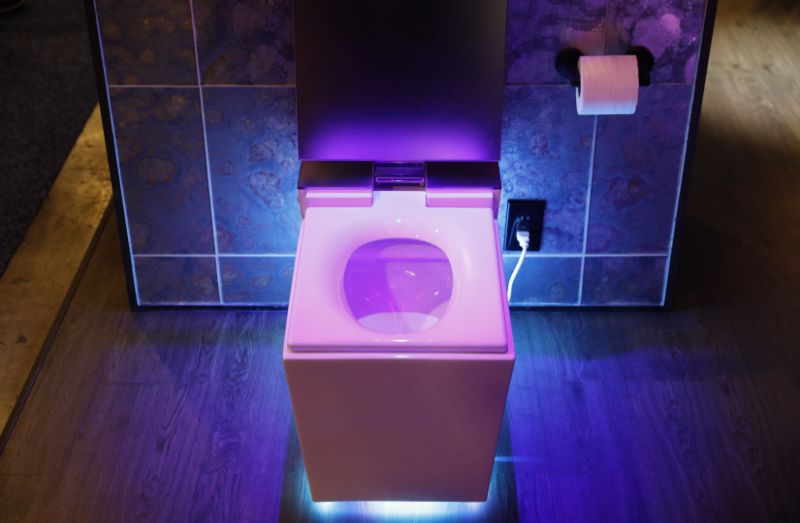Smartwatches Track Our Health. Smart Toilets, Too.
Commodes that measure your health and might even diagnose Covid-19 are in the works.
The next frontier of at-home health tracking is flush with data: the toilet.
Researchers and companies are developing high-tech toilets that go beyond adding smart speakers or a heated seat. These smart facilities are designed to look out for signs of gastrointestinal disease, monitor blood pressure or tell you that you need to eat more fish, all from the comfort of your personal throne.
“All of the things that have come with smartwatches and phones, you can imagine that on another scale,” says Joshua Coon, a bioanalytical chemist at the University of Wisconsin-Madison and Morgridge Institute for Research, who published a 2019 study exploring the potential of continuously monitoring a person’s health by looking at molecules in their urine samples. “You could really start to understand disease risk.”
Doctors have long used fecal and urine samples for clues to people’s health, but there has been a renewed interest in recent years as scientists have begun to better understand how the microbes in our gut influence our well-being. In the Covid-19 pandemic, more communities launched wastewater surveillance initiatives, enabling health officials to hunt for early signs of the virus in cities and neighbourhoods and track its spread.
Some researchers want to harness that wealth of information on the individual level and have come up with models to peer into the toilet bowl remotely. Some smart toilets are geared toward helping doctors monitor patients with chronic conditions or heightened risk for certain diseases, whereas other companies aim to sell the toilets—with price tags in the hundreds or thousands of dollars—directly to consumers as a tool to track or improve their own health and wellness.
Researchers at Stanford School of Medicine have outfitted a toilet bowl with cameras and trained a machine-learning algorithm to analyze the waste against a diagnostic chart. The toilet can also track the flow, colour and volume of urine. It is equipped with a urine test strip similar to a pregnancy test that detects specific molecules that can provide insight into a person’s health. To tell users apart, the toilet has both a fingerprint scan when a person flushes and a scan of their anus’s characteristics, or an anal print.
The Stanford team has signed an agreement with Izen, a Korean toilet maker, to manufacture the toilet. They hope to have working prototypes that can be used in clinical trials by the end of this year, says Seung-min Park, who leads the project, which was started by Sanjiv Gambhir, the former chair of radiology at Stanford, who died in 2020.
Another prototype smart toilet developed at Duke University also deploys cameras and machine learning to analyze waste after it has been flushed. It uses other sensors to capture consistency, presence of blood and specific proteins and extracts a small vial of stool that can be shipped off to a lab for further analysis. The smart toilet, along with others in development, is designed to connect with an app on a person’s phone.
“[You could] get personalized alerts for having more fibre or avoiding certain foods to avoid flare-ups,” says Sonia Grego, founder of the Duke Smart Toilet Lab and Coprata Inc., a startup that she and two other team members launched in 2021 to commercialize the technology.
A remote smart toilet could help doctors monitor patients with chronic conditions such as irritable bowel syndrome or spot early signs of disease, says Dr. Grego. Another plus is that it could allow for frequent measurements that can be tracked over time, which could be a more effective, non-invasive way to track certain metrics and quickly identify and flag changes than sporadic readings during doctor’s visits.
“What your blood pressure is at 2 p.m. on a Tuesday doesn’t matter. To get that information with real trends behind it is super valuable,” says Austin McChord, the chief executive of Casana, a home-health monitoring startup working on a toilet seat that can measure vital signs including blood pressure, blood-oxygen levels or heart rate.
The company said in February that it had raised $14 million in Series A funding and is working toward getting clearance from the Food and Drug Administration for the seat to measure a handful of vital signs, Mr. McChord says.
Some diagnostics experts argue that the value in a smart toilet would come from being able to analyze the molecular substances in patient samples and that other devices, including smartwatches, can easily monitor blood pressure and heart rate. Mr. McChord and others working on smart-toilet technology say that advantages to using a toilet seat over another wearable device are adherence and ease-of-use.
“If you want someone to use something, it has to be incredibly simple,” says Chad Adams, president and chief executive of the company Medic.Life, which is working to get FDA clearance for its Medic.Lav smart toilet. “Everybody has to go to the bathroom.”
Medic.Life first plans to sell its toilet to assisted living facilities, where it could help track residents’ vital signs, bodyweight or even the sugar or sodium levels in their urine, among other metrics, before expanding to general consumers. A future version for assisted living facilities, pharmacies and healthcare providers would diagnose certain infections, such as urinary-tract infections or Covid-19.
Google LLC also has a patent for a toilet seat that doubles as a cardiovascular monitor, filed in 2015, although it isn’t clear whether the company is pursuing the project. Google Health declined to comment. Toilet maker Toto is designing a toilet that could analyze people’s waste and provide recommendations to improve wellness, such as drinking more water or adding something to their diets. The company anticipates launching the toilet in the next several years.
Toilet makers say that their products can provide medical-grade results for some vital signs and urine tests, but a smart toilet that can analyze the broader chemical makeup of waste is likely further off. Developers will have to work out how to prepare samples for analysis and refill the chemicals needed to run the reaction, as well as make the toilet cost-effective, biochemists and diagnostic experts say.
Another key barrier is privacy. A 300-person survey conducted by the Stanford team found that one third of respondents were uncomfortable with the concept of a smart toilet that collects health data, with many citing privacy as a chief concern. Respondents were especially uncomfortable with the camera-based approach. More than half, however, were at least somewhat comfortable with a smart toilet.
“I have now heard every toilet pun or joke you can imagine,” Casana’s Mr. McChord says. “A toilet seat is something that everyone is going to giggle about, but you have that moment to explain what it really does, and people really do see the value there.”
 Copyright 2020, Dow Jones & Company, Inc. All Rights Reserved Worldwide. LEARN MORE
Copyright 2020, Dow Jones & Company, Inc. All Rights Reserved Worldwide. LEARN MORE
This stylish family home combines a classic palette and finishes with a flexible floorplan
Just 55 minutes from Sydney, make this your creative getaway located in the majestic Hawkesbury region.
As Paris makes its final preparations for the Olympic games, its residents are busy with their own—packing their suitcases, confirming their reservations, and getting out of town.
Worried about the hordes of crowds and overall chaos the Olympics could bring, Parisians are fleeing the city in droves and inundating resort cities around the country. Hotels and holiday rentals in some of France’s most popular vacation destinations—from the French Riviera in the south to the beaches of Normandy in the north—say they are expecting massive crowds this year in advance of the Olympics. The games will run from July 26-Aug. 1.
“It’s already a major holiday season for us, and beyond that, we have the Olympics,” says Stéphane Personeni, general manager of the Lily of the Valley hotel in Saint Tropez. “People began booking early this year.”
Personeni’s hotel typically has no issues filling its rooms each summer—by May of each year, the luxury hotel typically finds itself completely booked out for the months of July and August. But this year, the 53-room hotel began filling up for summer reservations in February.
“We told our regular guests that everything—hotels, apartments, villas—are going to be hard to find this summer,” Personeni says. His neighbours around Saint Tropez say they’re similarly booked up.
As of March, the online marketplace Gens de Confiance (“Trusted People”), saw a 50% increase in reservations from Parisians seeking vacation rentals outside the capital during the Olympics.
Already, August is a popular vacation time for the French. With a minimum of five weeks of vacation mandated by law, many decide to take the entire month off, renting out villas in beachside destinations for longer periods.
But beyond the typical August travel, the Olympics are having a real impact, says Bertille Marchal, a spokesperson for Gens de Confiance.
“We’ve seen nearly three times more reservations for the dates of the Olympics than the following two weeks,” Marchal says. “The increase is definitely linked to the Olympic Games.”

Getty Images
According to the site, the most sought-out vacation destinations are Morbihan and Loire-Atlantique, a seaside region in the northwest; le Var, a coastal area within the southeast of France along the Côte d’Azur; and the island of Corsica in the Mediterranean.
Meanwhile, the Olympics haven’t necessarily been a boon to foreign tourism in the country. Many tourists who might have otherwise come to France are avoiding it this year in favour of other European capitals. In Paris, demand for stays at high-end hotels has collapsed, with bookings down 50% in July compared to last year, according to UMIH Prestige, which represents hotels charging at least €800 ($865) a night for rooms.
Earlier this year, high-end restaurants and concierges said the Olympics might even be an opportunity to score a hard-get-seat at the city’s fine dining.
In the Occitanie region in southwest France, the overall number of reservations this summer hasn’t changed much from last year, says Vincent Gare, president of the regional tourism committee there.
“But looking further at the numbers, we do see an increase in the clientele coming from the Paris region,” Gare told Le Figaro, noting that the increase in reservations has fallen directly on the dates of the Olympic games.
Michel Barré, a retiree living in Paris’s Le Marais neighbourhood, is one of those opting for the beach rather than the opening ceremony. In January, he booked a stay in Normandy for two weeks.
“Even though it’s a major European capital, Paris is still a small city—it’s a massive effort to host all of these events,” Barré says. “The Olympics are going to be a mess.”
More than anything, he just wants some calm after an event-filled summer in Paris, which just before the Olympics experienced the drama of a snap election called by Macron.
“It’s been a hectic summer here,” he says.

AFP via Getty Images
Parisians—Barré included—feel that the city, by over-catering to its tourists, is driving out many residents.
Parts of the Seine—usually one of the most popular summertime hangout spots —have been closed off for weeks as the city installs bleachers and Olympics signage. In certain neighbourhoods, residents will need to scan a QR code with police to access their own apartments. And from the Olympics to Sept. 8, Paris is nearly doubling the price of transit tickets from €2.15 to €4 per ride.
The city’s clear willingness to capitalise on its tourists has motivated some residents to do the same. In March, the number of active Airbnb listings in Paris reached an all-time high as hosts rushed to list their apartments. Listings grew 40% from the same time last year, according to the company.
With their regular clients taking off, Parisian restaurants and merchants are complaining that business is down.
“Are there any Parisians left in Paris?” Alaine Fontaine, president of the restaurant industry association, told the radio station Franceinfo on Sunday. “For the last three weeks, there haven’t been any here.”
Still, for all the talk of those leaving, there are plenty who have decided to stick around.
Jay Swanson, an American expat and YouTuber, can’t imagine leaving during the Olympics—he secured his tickets to see ping pong and volleyball last year. He’s also less concerned about the crowds and road closures than others, having just put together a series of videos explaining how to navigate Paris during the games.
“It’s been 100 years since the Games came to Paris; when else will we get a chance to host the world like this?” Swanson says. “So many Parisians are leaving and tourism is down, so not only will it be quiet but the only people left will be here for a party.”
This stylish family home combines a classic palette and finishes with a flexible floorplan
Just 55 minutes from Sydney, make this your creative getaway located in the majestic Hawkesbury region.






















